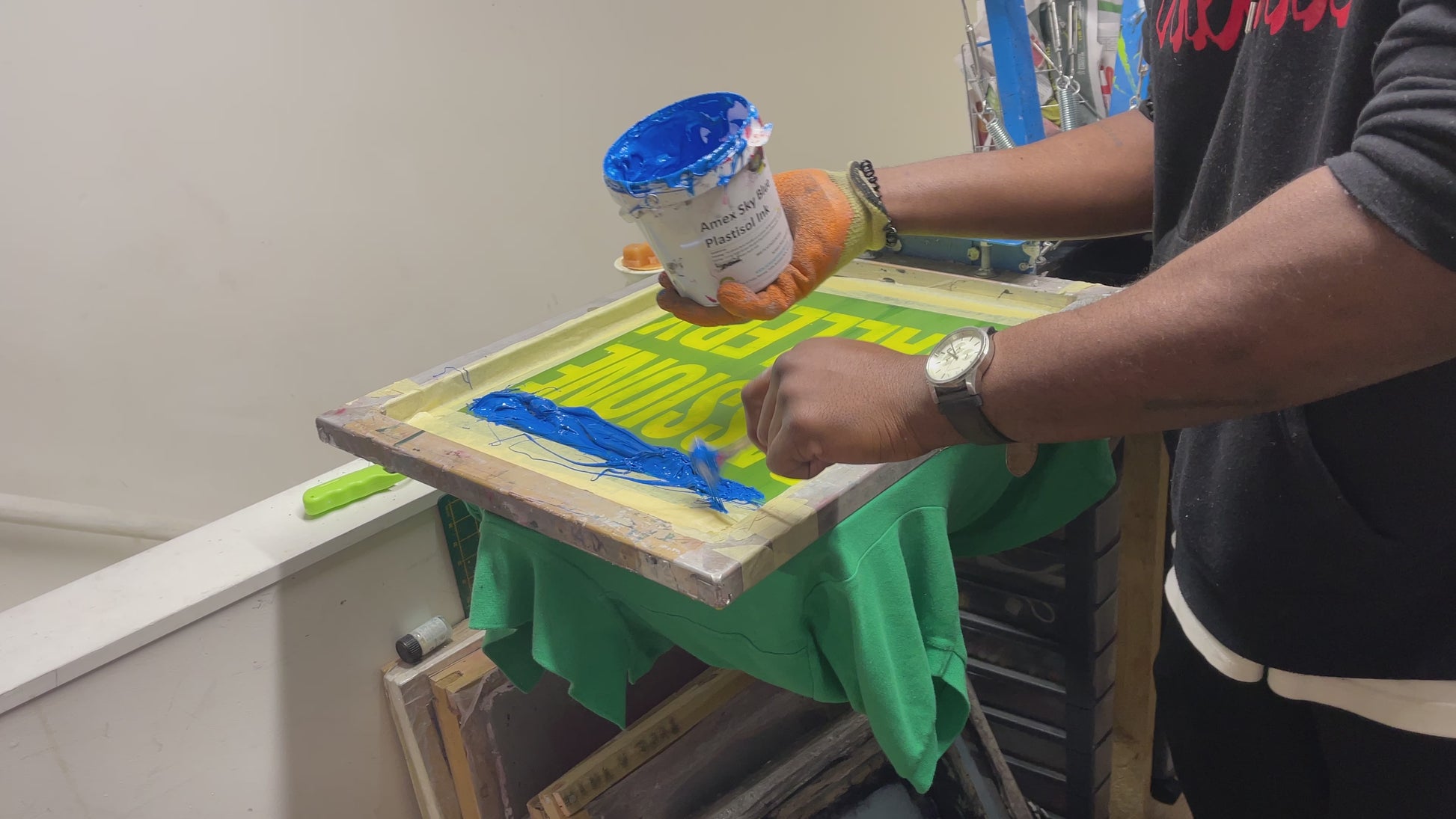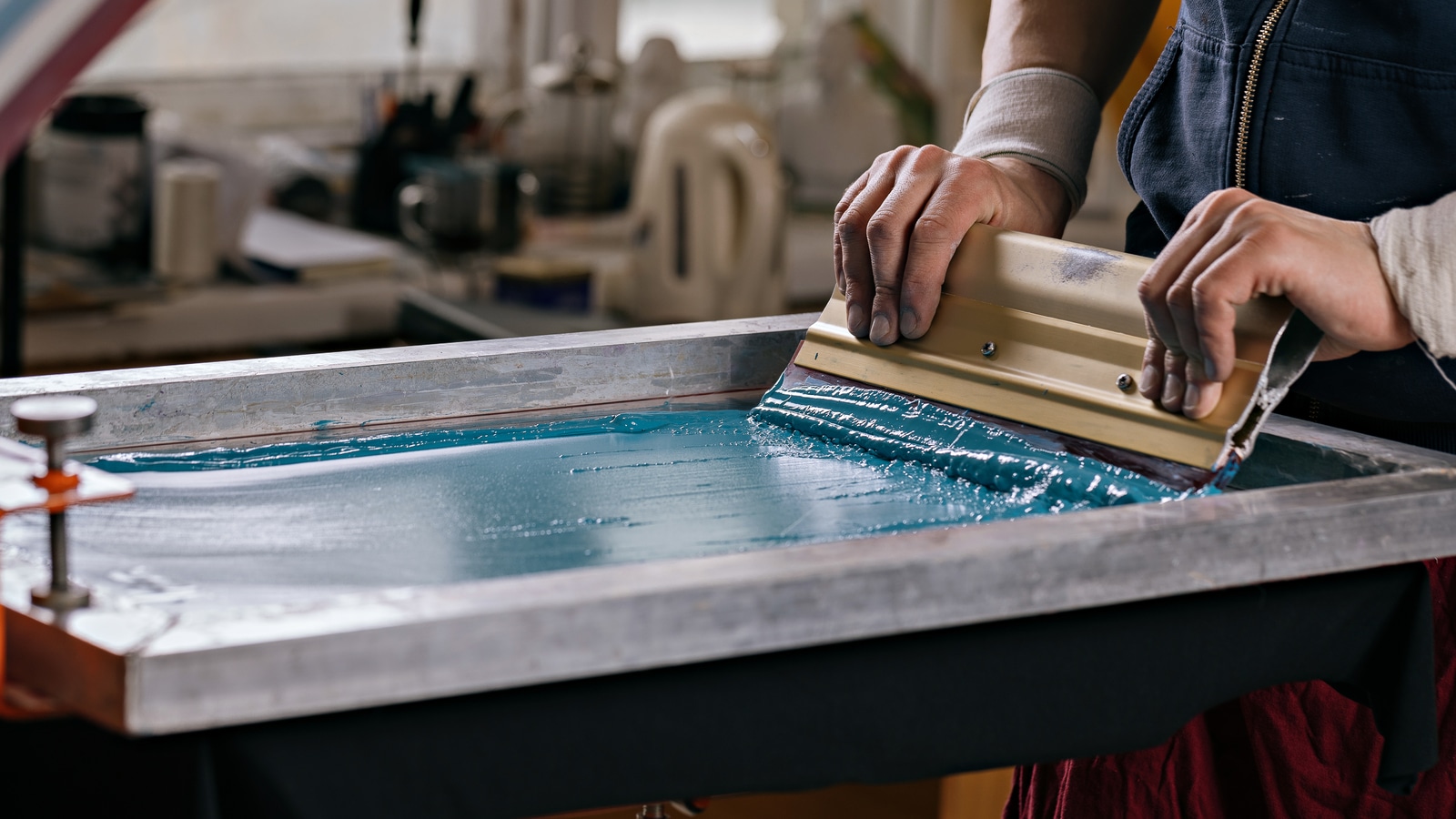Display Printing Uncovered: Whatever You Required to Understand About Tee Shirt and Garment Printing Techniques
Display printing is an interesting technique that integrates art with technique, supplying endless opportunities for imagination. Prepared to discover the important elements that make display printing an art type?
The Essentials of Screen Printing: How It Functions
When you dive into display printing, you'll find it's both a science and an art. At its core, display printing includes creating a pattern, or screen, that permits ink to pass through just in particular locations.
Following, you'll mix your inks and prepare your printing surface area. Position the display over the fabric, after that utilize a squeegee to push ink with the display onto the garment. This process needs precision, as you want clear, vivid prints. After printing, you'll cure the ink with warmth, ensuring it sticks to the material and lasts with washes. Each action is essential, and understanding them will raise your display printing abilities, transforming straightforward garments into unique, expressive pieces.
Sorts Of Screen Printing Methods
Once you grasp the essentials of screen printing, it's time to check out the various strategies that can boost your styles. One popular technique is traditional screen printing, where ink is pushed via a stenciled display. This method is excellent for vibrant, vibrant colors. Then there's water-based ink printing, which provides a softer feel and is eco-friendly, but it requires a various strategy to healing.
If you're aiming for fine information, consider discharge printing. This method eliminates dye from the fabric, leaving a soft, classic look. An additional choice is plastisol printing, understood for its longevity and vivid shades, making it a preferred for numerous brands. Ultimately, explore halftone printing to produce slope impacts and elaborate layouts. Each method has its distinct charm, so do not be reluctant to try them bent on discover what suits your design best!
Vital Equipment for Screen Printing
To accomplish sensational cause display printing, having the appropriate tools is basic. You'll need a strong display printing framework, which holds the mesh that transfers your style onto the garment. Next off, buy high-grade mops; these are important for using ink equally across the display. You'll also require a great direct exposure unit to develop your screens, in addition to a washout cubicle for cleansing them after use. A trusted warmth source, like a conveyor dryer or warm press, is crucial for treating your prints to assure long life. Don't forget a correct work area, geared up with tables and storage space for your products. Protective gear, such as gloves and masks, will certainly maintain you secure from chemicals and inks. With the right devices, you'll be well on your way to producing professional-quality prints.
Selecting the Right Inks and Materials
When selecting inks and materials for display printing, you need to consider the kind of ink that works ideal for your project. Believe concerning textile compatibility to ensure your styles look terrific and last long. Also, discover environmentally friendly ink options to make your printing process a lot more sustainable.
Kinds Of Screen Inks
Selecting the ideal screen ink is vital for achieving dynamic, long lasting prints that satisfy your project's demands. There are several sorts of screen inks to examine. Plastisol ink is preferred for its adaptability and simplicity of usage, providing superb color opacity on dark fabrics. Water-based ink, on the other hand, offers a softer feeling and is environmentally friendly, making it ideal for those wanting to lessen their environmental effect. Discharge inks get rid of color from the fabric, causing a soft, vintage appearance however need details handling. Lastly, specialized inks, such as glow-in-the-dark or metallic, can include unique results to your designs. Assess your job requirements and pick the ink that lines up ideal with your preferred end result.

Material Compatibility Factors To Consider
Recognizing textile compatibility is essential for achieving top notch display prints, specifically given that various products react distinctively to numerous inks. When selecting inks, take into consideration the material type-- cotton, polyester, or blends. For cotton, water-based inks work well, providing softness and breathability. Polyester, on the various other hand, usually calls for plastisol inks for much better attachment and dynamic colors. You might need to make use of a combination of both types if you're publishing on blends. Constantly examine your inks on sample fabric to assure they stick properly and keep shade integrity. In addition, bear in mind that fabric weight and structure can influence the final result, so selecting the best ink and product combo is vital for your task's success.
Eco-Friendly Ink Options
Environment-friendly inks are ending up being a preferred selection for display printers that want to decrease their ecological influence while maintaining top quality. When choosing inks, think about water-based inks, which are much less unsafe and easier to clean up contrasted to typical solvents.
In addition, look for inks made from renewable energies, such as soy or vegetable-based choices. By selecting the ideal inks and products, you'll not only develop spectacular designs but also add to an extra lasting printing procedure. Make the switch, and your prints will certainly show your dedication to the setting!
Preparing Your Layout for Display Printing

Submit Style Needs
To guarantee your design looks sharp and lively on fabric, you'll need to pay close interest to file style demands for screen printing. Make certain your layout has a clear history to protect against undesirable white edges on your prints. Maintain shade settings in mind; CMYK is basic for screen printing, so convert your RGB develops appropriately.
Color Separation Methods
Color separation is an essential action in preparing your layout for screen printing, and mastering it can greatly improve your print high quality. You'll need to break your design into private colors, as each shade calls for a separate screen throughout printing. Start by determining all the colors in your design and create layers each. You can utilize software application like Adobe Photoshop or Illustrator to isolate and separate colors efficiently. Be particular to conserve each layer as a separate file, generally in a format like TIFF or PSD. This precision not only assures precise color depiction however additionally enhances the printing process. By paying interest to color separation, you'll achieve professional and vivid cause your screen-printed garments.
Resolution and Dimension
Accomplishing the most effective results in display printing starts with guaranteeing your style has the right resolution i was reading this and size. Preferably, your artwork must be at the very least 300 DPI (dots per inch) for sharp, clear prints. If you use reduced resolution, your final item might look less than professional and pixelated.
When it pertains to dimension, think about the measurements of your print location. Style your art work to match the final print size, ideally developing it in the actual measurements you'll be publishing. In this manner, you'll prevent any kind of unforeseen scaling issues.
Constantly check your design in both vector and raster formats. Vector graphics can be scaled without shedding quality, making them ideal for display printing. Preparing appropriately will ensure your layout looks outstanding on every garment!
Step-by-Step Display Printing Process
Display printing is a dynamic procedure that enables you to produce lively styles on different surfaces. To get started, you'll require a display, solution, and your chosen ink.
Pour ink onto the display and utilize a squeegee to push the ink via the pattern onto the fabric. Raise the screen carefully and allow the print dry. You've successfully display printed your layout.
Tips for Effective Screen Printing Projects
While you're diving into your display printing projects, keep in mind that prep work is essential to success. Start by collecting all your products-- inks, screens, squeegees, and garments. A tidy work space aids protect against unwanted mistakes, so tidy up prior to you start.
Following, verify your artwork is high-resolution and properly sized for your garment. Examine your display for proper direct exposure and tidy it completely to stay clear of spots. When mixing your inks, adhere to the producer's standards to achieve the appropriate uniformity.
During printing, apply also stress with your squeegee for constant results. Don't hurry; take your time to verify each print satisfies your criteria. After printing, let your garments dry completely prior to handling or packaging them.
Lastly, constantly keep a sample of your job for future reference. In this manner, you can evaluate your progression and boost your techniques gradually. Satisfied printing!

Regularly Asked Concerns
How much time Does It Require To Establish a Screen Printing Job?
Establishing a screen printing job usually takes about thirty minutes to an hour. You'll prepare the displays, mix inks, and change the press. The time differs based upon intricacy and experience, so remain organized!
Can I Print on Various Material Enters Utilizing the Same Method?
Yes, you can publish on different textile types using my website the same technique, however you'll need to change your inks and settings. Some materials absorb ink in a different way, so exploring assurances the best results for each and every product.
What Prevail Mistakes to Stay Clear Of in Screen Printing?
When screen printing, stay clear of typical blunders like utilizing the incorrect ink, disregarding appropriate exposure times, or missing pre-press checks. Always test your setup and maintain tidy screens to assure high quality outcomes each time.
How Can I Properly Tidy and Maintain My Display Printing Equipment?
To effectively tidy and description maintain your display printing equipment, you need to regularly wash displays with appropriate solvents, inspect mops for wear, and ensure all devices are saved dry and dust-free. Consistency stops costly repairs and boosts efficiency.
Is Display Printing Eco-friendly Contrasted to Other Techniques?
Display printing can be a lot more environmentally friendly than various other methods, particularly if you use water-based inks and eco-conscious products. By choosing sustainable materials and practices, you reduce waste and lessen your influence on the planet.
Screen Printing Uncovered: Whatever You Required to Know Regarding Tee Shirt and Garment Printing Strategies
At its core, display printing involves producing a pattern, or screen, that allows ink to pass with just in details areas. Setting the display over the textile, after that use a squeegee to push ink through the display onto the garment. One preferred method is traditional screen printing, where ink is pushed through a stenciled display.When choosing inks and materials for display printing, you require to take into account the type of ink that functions finest for your job.